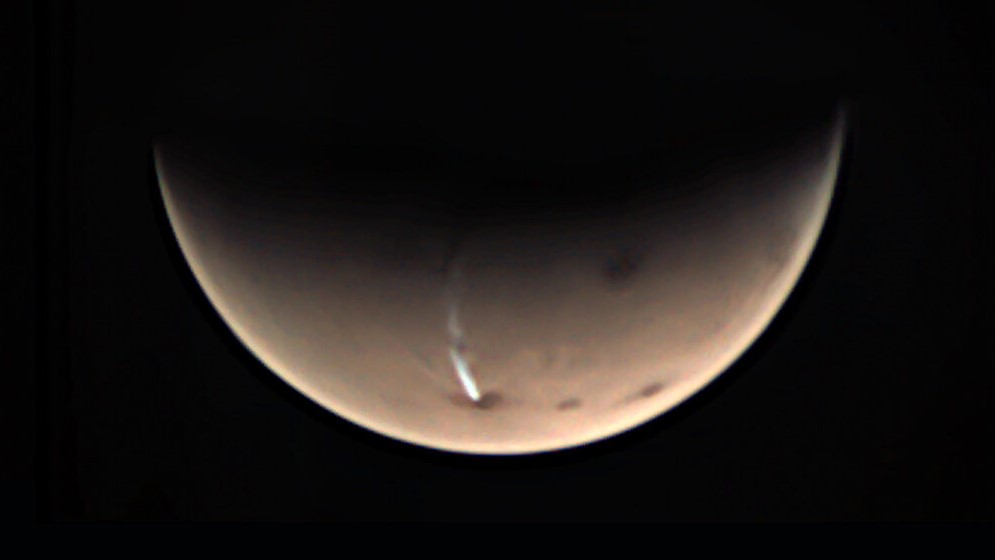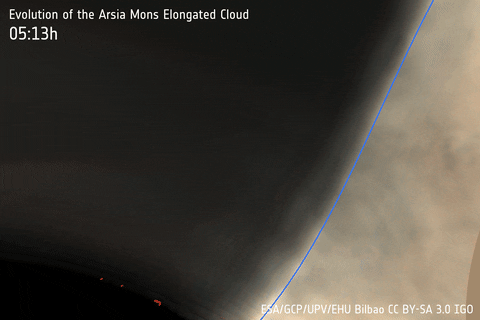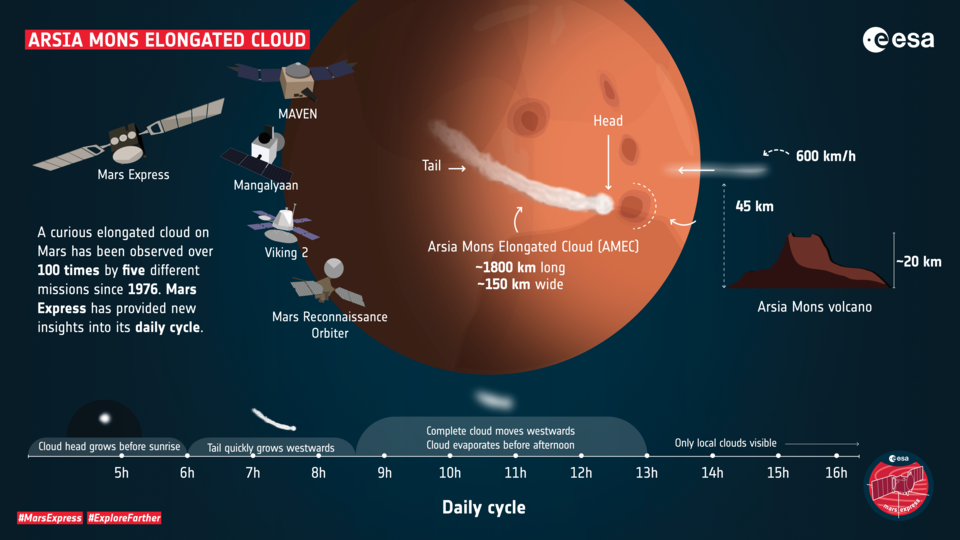The weird long cloud on Mars is finally revealing some of its secrets
A European spacecraft is unraveling the secrets of the weird long cloud that has been appearing again and again in the Martian sky for years.
The Arsia Mons Elongated Cloud is a peculiar feature on Mars: a long, bright water ice cloud stretching out over the Martian surface, extending over the planet's Arsia Mons volcano all the way to the volcano Olympus Mons, the tallest mountain in the solar system. The strange phenomenon has been recurring every year around Mars' southern solstice, with the cloud forming and fading daily for 80 or more days at a time on the Red Planet.
However, while the cloud is no new presence, it is challenging to observe in its entirety because of the changing Martian atmosphere and the difficulties of observing from orbit. Still, the European Space Agency's Mars Express orbiter has managed to get an in-depth look at the peculiar cloud using a special tool: the Visual Monitoring Camera (VMC), perhaps better known by its nickname the Mars Webcam.
In a new study, astronomers using this data are gleaning new details about the long cloud, including how big it can really get and details of the intricate dynamics at play in the climate system surrounding it.
Photos: Red Planet views from Europe's Mars Express

Cloud-hunting tools
The VMC was originally installed to spot the Beagle 2 lander, a British Mars lander that was declared lost and is speculated to have crashed.
"However, recently, the VMC was reclassified as a camera for science," Jorge Hernández Bernal, an astronomer at the University of the Basque Country in Spain and lead author of this new study of the cloud who also is part of a long-term project studying the cloud, said in a statement.
Get the Space.com Newsletter
Breaking space news, the latest updates on rocket launches, skywatching events and more!
"Repurposing the VMC has successfully enabled us to understand this transient cloud in a way that wouldn’t have been possible otherwise," ESA's Mars Express project scientist Dmitrij Titov said about the VMC in the same statement.

The tool allows scientists to "track clouds, monitor dust storms, probe cloud and dust structures in the Martian atmosphere, explore changes in the planet’s polar ice caps, and more," Titov added.
For this study, astronomers used both the VMC observations and data from other Mars Express instruments in addition to data from other missions including NASA's Mars Atmosphere and Volatile Evolution (MAVEN) Mars Reconnaissance Orbiter (MRO), the Viking 2 missions and the Indian Space Research Organization's Mars Orbiter Mission (MOM).
"We were especially excited when we dug into Viking 2’s observations from the 1970s," Bernal said. "We found that this huge, fascinating cloud had already been partially imaged that long ago — and now we’re exploring it in detail."
Mars Illusion Photos: The 'Face on Mars' and Other Martian Tricks
Cloudy clues

The researchers found that, at its largest, the cloud measures out to be about 1,118 miles (1,800 kilometers) long and 93 miles (150 km) across. The cloud is "orographic," meaning it forms when wind is pushed upward by surface features like mountains (in this case, Arsia Mons), and is the largest cloud of this type ever seen on the planet.
The cloud is also highly dynamic, they found, forming before sunrise then expanding rapidly for two and a half hours. It can grow at a mind-boggling speed of over 373 mph (600 kph) before it stops expanding. It then detaches from where it formed and is stretched even more before evaporating in the late morning. On Earth, orographic clouds are never as big as this Martian cloud, nor as dynamic, making it especially strange.
Now that the researchers have better handle on the life cycle and patterns of this phenomena, it will enable them to more easily target and observe the cloud.
"Many Mars orbiters cannot begin observing this part of the surface until the afternoon due to the properties of their orbits, so this really is the first detailed exploration of this interesting feature — and it’s made possible by not only Mars Express’ diverse suite of instruments, but also its orbit," study co-author Agustin Sánchez-Lavega, the science lead for the VMC and a professor of physics at the University of the Basque Country, said in the same statement.
This work was first published Dec. 20in a study in the Journal of Geophysical Research and was released in Volume 126 of Issue 3 in March 2021.
Email Chelsea Gohd at cgohd@space.com or follow her on Twitter @chelsea_gohd. Follow us on Twitter @Spacedotcom and on Facebook.
Join our Space Forums to keep talking space on the latest missions, night sky and more! And if you have a news tip, correction or comment, let us know at: community@space.com.

Chelsea “Foxanne” Gohd joined Space.com in 2018 and is now a Senior Writer, writing about everything from climate change to planetary science and human spaceflight in both articles and on-camera in videos. With a degree in Public Health and biological sciences, Chelsea has written and worked for institutions including the American Museum of Natural History, Scientific American, Discover Magazine Blog, Astronomy Magazine and Live Science. When not writing, editing or filming something space-y, Chelsea "Foxanne" Gohd is writing music and performing as Foxanne, even launching a song to space in 2021 with Inspiration4. You can follow her on Twitter @chelsea_gohd and @foxannemusic.









